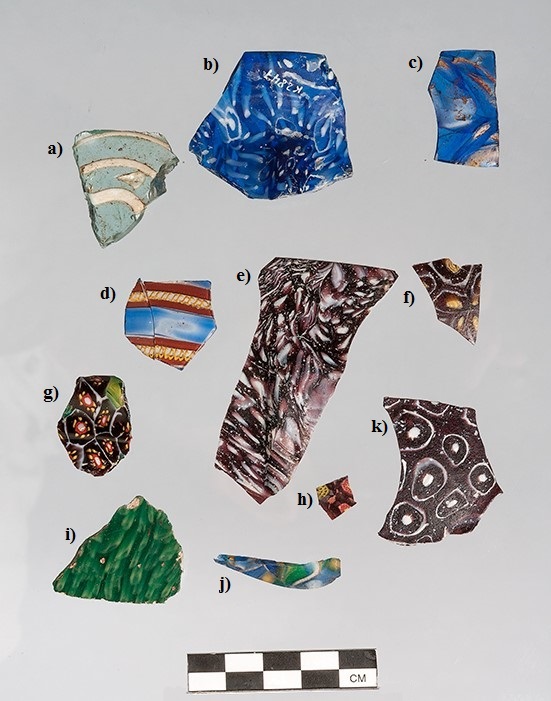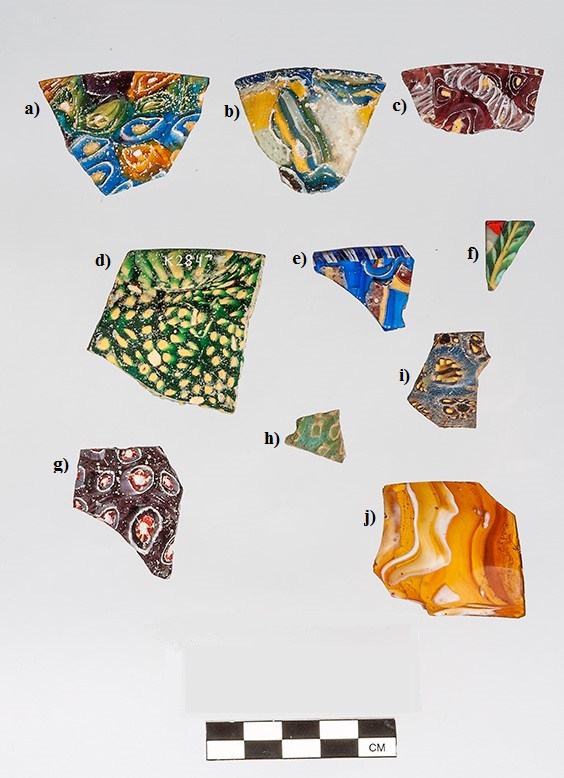Acquisition number: 2001.04
First Illustration
a) Base of shallow vessel, opaque white trail on translucent blue-greenish glass. Probably first century AD, blown?
b) Early Roman rim of pillar-moulded bowl in mosaic-cane, translucent cobalt, marbled white. Late first century BC – early first century ad. Parallel: Grose, Early Ancient Glass (1989) 281 no. 300. In white on the outside: K2847.
c) Very abraded cameo glass? Julio-Claudian.
d) Two joining fragments of striped mosaic-cane bowl in translucent light cobalt blue with parallel (?) segments of clear with yellow thread reticella canes, each encased in thick opaque red with thin white outer coating. This is an unusual but not unknown pattern for the use of reticella canes, usually laid asymmetrically next to opaque canes. The colours are also unusual, and this could be from the 19th century.
e) Early Roman fragment of pillar-moulded bowl in marbled mosaic-cane, aubergine and white. Parallel: Grose, Early Ancient Glass (1989) 274, no. 274. Late first century BC – early first century AD.
f) Hellenistic fragment of bowl in spiral mosaic-cane: amber spirals in aubergine edged in white, set in aubergine fabric. For a discussion on the spiral-cane motif as quintessentially Hellenistic, see Grose, Early Ancient Glass (1989) 189-190.
g) Fragment of millefiori bowl or plate: white centres ringed in opaque red with yellow petals in dark green canes, cased in white, with some green canes set on side. Late first century BC – early first century AD.
h) Tiny millefiori body fragment: dark amber (?) fabric with yellow segmented centres and red and white segmented petals. Late first century BC – early first century AD.
i) Fragment of green plate or wall-plaque with white circular mosaic-canes, laid at angles. This is a common form of inlay-plaque, found in Egypt and also Rome. For the type, see Grose, Early Ancient Glass (1989) 368-9 and nos 658-667. First century AD.
j) Fragment of flask or bowl in green, yellow white and blue short strip mosaic cane. Late first century BC – early first century AD.
k) Fragment of bowl, probably Hellenistic, like (e) in aubergine and white mosaic cane, but left simple, without the marbling effect.
Second Illustration
a) Fragment of bowl with circular mosaic canes with central dot: blue with yellow centre and white edge, amber with white centre and white edge, and green with white centre and white edge, all set in dark green. Late first century BC – early first century AD.
b) Bowl lip fragment with twisted cane on rim, short strip mosaic cane in yellow, white, green and blue. Late first century BC – early first century AD.
c) Hellenistic fragment of composite spiral cane and segments of reticella canes, all aubergine; spiral mosaic canes with yellow centre and white spiral, reticella white and aubergine. Second – first century BC. For a discussion on the spiral-cane motif as quintessentially Hellenistic, see Grose, Early Ancient Glass (1989) 189-190.
d) Fragment of lip of a plate (?) of millefiori mosaic-cane: white centre with yellow petals, in dark green fabric. Late first century BC – early first century AD. In white on the outside: K2847.
e) Lip of bowl of short strip mosaic cane bowl; double-twisted cane on rim in cobalt and white; short segments in aubergine, yellow and dark cobalt, in cobalt fabric. Late first century BC – early first century AD.
f) Ptolemaic inlay plaque with vegetal motifs: frond with yellow stem and short green leaves, flanked by lotus flowers in white, yellow and tipped in red. Identical motifs on Grose, Early Ancient Glass (1989) 366, no. 648. Third – first century BC.
g) Hellenistic fragment of bowl in aubergine with mosaic-canes: red stars with large white centres in white circles. Third – first century BC. See Grose, Early Ancient Glass (1989) 190.
h) Tiny fragment of plate or inlay-plaque with irregular white circular mosaic canes in translucent green. Early Roman.
i) Fragment of millefiori mosaic-cane: large dark amber flowers with yellow petals, in translucent blue fabric. Late first century BC – early first century AD.
j) Fragment of bowl in marbled mosaic-cane: amber and white. Early Roman.
Title: 21 Fragments of Augustan-Julio-Claudian Plates and Bowls - 2001.04
Acquisition number: 2001.04
Author or editor: J.R. Green
Culture or period: Roman Imperial
Date: 1st century BC - 1st century AD.
Material: Glass
Object type: Plate
Origin region or location: Italy
Display case or on loan: 9
Keywords: Roman, Imperial, Glass, Fragment
Bonhams and Brooks, London, Sale Cat., 26 April 2001, no. 273 (colour ill.).
2001.04
21 Fragments of Augustan-Julio-Claudian Plates and Bowls
Purchased.
Formerly in the Kofler-Truniger Collection.
Left to right, top to bottom:-
First Illustration
a) Base of shallow vessel, opaque white trail on translucent blue-greenish glass. Probably first century AD, blown?
b) Early Roman rim of pillar-moulded bowl in mosaic-cane, translucent cobalt, marbled white. Late first century BC – early first century ad. Parallel: Grose, Early Ancient Glass (1989) 281 no. 300. In white on the outside: K2847.
c) Very abraded cameo glass? Julio-Claudian.
d) Two joining fragments of striped mosaic-cane bowl in translucent light cobalt blue with parallel (?) segments of clear with yellow thread reticella canes, each encased in thick opaque red with thin white outer coating. This is an unusual but not unknown pattern for the use of reticella canes, usually laid asymmetrically next to opaque canes. The colours are also unusual, and this could be from the 19th century.
e) Early Roman fragment of pillar-moulded bowl in marbled mosaic-cane, aubergine and white. Parallel: Grose, Early Ancient Glass (1989) 274, no. 274. Late first century BC – early first century AD.
f) Hellenistic fragment of bowl in spiral mosaic-cane: amber spirals in aubergine edged in white, set in aubergine fabric. For a discussion on the spiral-cane motif as quintessentially Hellenistic, see Grose, Early Ancient Glass (1989) 189-190.
g) Fragment of millefiori bowl or plate: white centres ringed in opaque red with yellow petals in dark green canes, cased in white, with some green canes set on side. Late first century BC – early first century AD.
h) Tiny millefiori body fragment: dark amber (?) fabric with yellow segmented centres and red and white segmented petals. Late first century BC – early first century AD.
i) Fragment of green plate or wall-plaque with white circular mosaic-canes, laid at angles. This is a common form of inlay-plaque, found in Egypt and also Rome. For the type, see Grose, Early Ancient Glass (1989) 368-9 and nos 658-667. First century AD.
j) Fragment of flask or bowl in green, yellow white and blue short strip mosaic cane. Late first century BC – early first century AD.
k) Fragment of bowl, probably Hellenistic, like (e) in aubergine and white mosaic cane, but left simple, without the marbling effect.
Second Illustration
a) Fragment of bowl with circular mosaic canes with central dot: blue with yellow centre and white edge, amber with white centre and white edge, and green with white centre and white edge, all set in dark green. Late first century BC – early first century AD.
b) Bowl lip fragment with twisted cane on rim, short strip mosaic cane in yellow, white, green and blue. Late first century BC – early first century AD.
c) Hellenistic fragment of composite spiral cane and segments of reticella canes, all aubergine; spiral mosaic canes with yellow centre and white spiral, reticella white and aubergine. Second – first century BC. For a discussion on the spiral-cane motif as quintessentially Hellenistic, see Grose, Early Ancient Glass (1989) 189-190.
d) Fragment of lip of a plate (?) of millefiori mosaic-cane: white centre with yellow petals, in dark green fabric. Late first century BC – early first century AD. In white on the outside: K2847.
e) Lip of bowl of short strip mosaic cane bowl; double-twisted cane on rim in cobalt and white; short segments in aubergine, yellow and dark cobalt, in cobalt fabric. Late first century BC – early first century AD.
f) Ptolemaic inlay plaque with vegetal motifs: frond with yellow stem and short green leaves, flanked by lotus flowers in white, yellow and tipped in red. Identical motifs on Grose, Early Ancient Glass (1989) 366, no. 648. Third – first century BC.
g) Hellenistic fragment of bowl in aubergine with mosaic-canes: red stars with large white centres in white circles. Third – first century BC. See Grose, Early Ancient Glass (1989) 190.
h) Tiny fragment of plate or inlay-plaque with irregular white circular mosaic canes in translucent green. Early Roman.
i) Fragment of millefiori mosaic-cane: large dark amber flowers with yellow petals, in translucent blue fabric. Late first century BC – early first century AD.
j) Fragment of bowl in marbled mosaic-cane: amber and white. Early Roman.
On mosaic glass bowls it is worth noting those published by Christina Avronidaki in “The Glassware”, in N. Kaltsas et al. (eds), The Antikythera Shipwreck. The Ship, the Treasures, the Mechanism (Athens 2012) 132-145. The wreck is reliably dated in the second quarter of the first century BC.
The Kofler-Truniger collection covered a wide range of ancient material including glass (cf. E. Kofler-Truniger, Sammlung E. und M. Kofler-Truniger, Luzern [Lucerne 1964-1965] for an exhibition at the Kunsthaus, Zurich; H.W. Müller, Ägyptische Kunstwerke, Kleinfunde und Glas in der Sammlung E. und M. Kofler-Truniger, Luzern [Münchner ägyptologische Studien, 5, Berlin 1964] [non vidi]). The bulk of the glass was sold at Christie’s, London, on 5-6 March 1985 although some items appeared at Christie’s, London, 10 December 1986, and at Sotheby’s, London, on 6 December 1971.
Bonhams and Brooks, London, Sale Cat., 26 April 2001, no. 273 (colour ill.).

